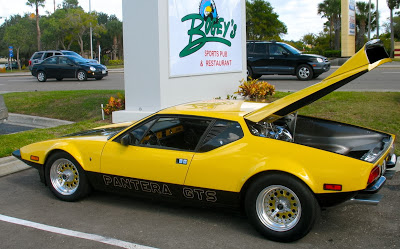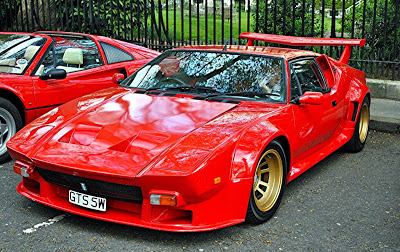Photos: Top, stock ’72 Pantera CARS Magazine test car in front of my house (1972);
above, Sarasota Cafe Racer Joe Curley’s twin-turbocharged Pantera GTS.
First shown to the public in Modena in March 1970, Pantera debuted the following month in the U.S. at the 14th New York International Auto Show, April 4 1970. Pantera, (Italian for Panther), started selling as a 1971 model at Lincoln-Mercury dealers. A little over 1,000 Vignale-bodied Panteras were sold, a high percentage plagued with rust (poor water drainage in the rear engine bay compartment), overheating and poor fit and finish. Ford used Holman & Moody to correct many of the mechanical malfunctions. Ford ended importation in 1975, after having sold approximately 5,500 cars. De Tomaso continued with the brand, in a variety of models,
some specifically for GT racing, until the mid-1990s.
For the complete Pantera story, check out check out Joe Breeze’s feature at Classic Driver,
http://www.classicdriver.com/en/article/cars/now-time-buy-de-tomaso-pantera?utm_medium=email&utm_campaign=Pantera%20Returns%20E&utm_content=Pantera%20Returns%20E%20CID_bc0e7c58fa2a9cb3074e74c20c768232&utm_source=newsletter&utm_term=Is%20now%20the%20time%20to%20buy%20a%20De%20Tomaso%20Pantera
For more information about Pantera, please visit http://www.panteracars.com/



